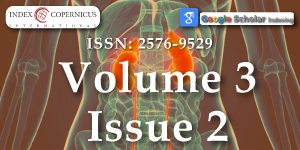Effectiveness of dexamethasone and hyaluronidase + valerate of bethasone associated with prepucial massage in the treatment of child phimosis
Main Article Content
Abstract
Introduction: The phimosis condition is characterized by the inability to retract the foreskin on the glans, making it impossible to expose them. Surgical treatment, although effective, has been questioned by the risk to which the patient is exposed. Therefore, we have opted for the use of topical corticosteroids to resolve this pathology.
Goals: To compare the effectiveness of Dexamethasone and Hyaluronidase + Betamethasone Valerate associated with preputial massage in the treatment of infantile phimosis, the degree of regression of phimosis, the time needed to achieve complete efficacy, possible adverse reactions, long-term outcome and parental adherence to treatment in children attending a specialized service in Blumenau, Santa Catarina.
Materials and methods: Controlled clinical trial, quantitative, non-blind, prospective and randomized sample analysis through the analysis of 523 patients.
Results: After 1 month of treatment, 435 patients presented some degree of regression and 63 children were referred to surgery. The success rate in this period was 45.8% in boys who were taking Hyaluronidase + Betamethasone Valerate and 49.8% in those who used Dexamethasone. In the late evaluation, 398 children reached grade 0, and 213 used Hyaluronidase + Betamethasone Valerate and 185, Dexamethasone; 39 patients were referred to the postectomy. Adherence to treatment was similar in both groups. The average time for degree 0 to be reached similar in both.
Conclusion: Both topical corticosteroids were effective in the resolution of phimosis. However, in the evaluation after the first month and in the regression, Dexamethasone proved to be more effective. The time to resolution of the condition was similar for both. The surgical procedure was taken when there was no clinical improvement. No adverse effects were reported in both groups.
Article Details
Copyright (c) 2019 da Rocha AK, et al.

This work is licensed under a Creative Commons Attribution 4.0 International License.
COSTA, Eduardo Corrêa; FRAGA, José Carlos Soares de. Urologia pediátrica: Fimose. In: PICON, Paula Xavier et al. Pediatria: consulta rápida. Porto Alegre: Artmed. 2010; 342-343.
Carnevale, José; Freitas Filho, Luiz Gonzaga de; MELO, Carlos Emanuel Rocha. Fimose. Pediatria Moderna, São Paulo. 2000; 36: 372-378.
PORTO, Celmo Celeno et al. Sistema urinário e órgãos genitais: Doenças dos órgãos genitais masculinos. In: PORTO, Celmo Celeno et al. Semiologia médica. 7. ed. Rio de Janeiro: Guanabara Koogan. 2014; 11: 928-929.
Kuehhas FE1, Miernik A, Sevcenco S, Tosev G, Weibl P, et al. Predictive Power of Objectivation of Phimosis Grade on Outcomes of Topical 0,1% Betamethasone Treatment of Phimosis. Urology. 2012; 80: 412-416. PubMed: https://bit.ly/2xvnR1N
Favorito LA, Balassiano CM, Rosado JP, Cardoso LE, Costa WS, et al. Structural analysis of the phimotic prepuce in patients with failed topical treatment compared with untreated phimosis. Int Braz J Urol. 2012; 38: 802-808. PubMed: https://bit.ly/2LCYljy
Nobre Yuri D, Freitas Ricardo G, Felizardo Maria J, Ortiz Valdemar, Macedo JR,et al. To circ or not to circ: clinical and pharmacoeconomic outcomes of a prospective trial of topical steroid versus primary circumcision. International Braz J Urol. 2010; 36: 75-85.
Lee CH, Lee SD. Effect of Topical Steroid (0.05% Clobetasol Propionate) Treatment in Children With Severe Phimosis. Korean J Urol. 2013; 54: 624-630. PubMed: https://bit.ly/2XtJJoG
Johnson PV: Childhood circumcision. Surgery. 2008; 26: 314-16.
Kikiros CS, Beasley SW, Woodward AA. The response of phimosis to local steroid application. Pediatr Surg. Int. 1993; 8: 329-32
Volpato Broering, Camilla; Crepaldi, Maria Aparecida. Preparação psicológica e o estresse de crianças submetidas a cirurgias. Psicologia em Estudo. 2011; 16: 15-23.
Yilmaz E, Batislam E, Bassar MM, Bassar H. Psychological trauma of circumcision in the phallic period could be avoided by using topical steroids. Int J Urol. Turquia. 2003; 10: 651-656. PubMed: https://bit.ly/2NxN32z
Benatar M, Benatar D. Between Prophylaxis and Child Abuse: The Ethics of Neonatal Male Circumcision. Am J Bioeth. 2003; 3: 35-48. PubMed: https://bit.ly/30fv02I
Darby R. Risks, Benefits, Complications and Harms: Neglected Factors in the Current Debate on Non-Therapeutic Circumcision. Kennedy Inst Ethics J. 2015; 25: 1-34. PubMed: https://bit.ly/2XtY7x7
Liu J, Yang J, Chen Y, Cheng S, Xia C, et al. Is steroids therapy effective in treating phimosis? A meta-analysis. Int Urol Nephrol. 2016; 48: 335-342. PubMed: https://bit.ly/2XnvmHk
Chu CC, Chen KC, Diau GY. Topical steroid treatment of phimosis in boys. J Urol. 1999; 162: 861–863
Monsour MA, Rabinovitch HH, Dean GE. Medical management of phimosis in children: our experience with topical steroids. J Urol. 1999; 162: 1162–1164. PubMed: https://bit.ly/2LEdAZw
Lund L, Wai KH, Mui M, Yeung CK.An 18-month follow-up study after randomized treatment of phimosis in boys with topical steroid versus placebo. Scand J Urol Nephrol. 2005; 39: 78-81. PubMed: https://bit.ly/2Jl4cHm
Zampieri N, Corroppolo M, Zuin V, Bianchi S, Camoglio FS. Phimosis and topical steroids: new clinical findings. Pediatr Surg Int. 2007; 23: 331-335. PubMed: https://bit.ly/2XnSnoF

